David Merkel writes: This piece is the sixth out of seven in a series that I have been writing at Aleph Blog.? Here are links to the first five pieces:
Recently I decided to spend some time analyzing the insurance industry.? It?s a different place today than when I became a buy-side analyst ten years ago.? Why?
First, for practical purposes, all of the insurers of credit are gone.? Yes, we have Assured Guaranty, and MBIA is limping along. Old Republic still exists. Radian and MGIC exist in reduced states.? The rest have disappeared.? In one sense, this should not have been a surprise, because the mortgage and credit guaranty businesses never had a scientific model for reserving.? I?m not even sure it is possible to have that.
Second, the title insurers are diminished.? Some, like LandAmerica are gone. Fidelity National seems to be diversifying itself out of insurance, buying up a restaurant chain last year.
Third, health insurers face an uncertain future.? Obamacare may disappear, or Obamacare could slowly eliminate insurers.? It?s a mess.? Insurers debate to what degree they should compete in insurance exchanges.
But beyond all of that, valuations are fair-to-cheap across the insurance industry.? Part of that may stem from ETFs.? Insurers as a whole are smaller than the banks, but not as much smaller as they used to be.? Now, if you are a hedge fund, and you want to short banks, you probably have the best liquidity shorting a basket of financials, which shorts insurers as well.
That may be part of the issue.? There are other aspects, which I will try to address as I go through subindustries.
Offshore
By ?Offshore? I mean P&C reinsurers and secondarily insurers that do business significantly in the US, and who list primarily on US exchanges, but are not based in the US.? Most of them are located in Bermuda.
In 2011-2012, many of them were challenged by the high levels of catastrophes globally.? But the prices of the reinsurers did not fall because pricing power returned, and investors expect higher future earnings as a result.
Before I go on, I need to explain that what I will use to give a rough analysis of value is a Price-to-Book vs Return on Equity analysis [PB-ROE].? For more details, you can read my article here.? The short explanation is that companies in the insurance business (and other financials) are constrained by the amount of equity (net worth) that they have.? The ability to earn a return as a percentage of the equity [ROE] drives the market valuation as a fraction of the equity [P/B].
Here is a scatterplot for PB-ROE for the Offshore group:
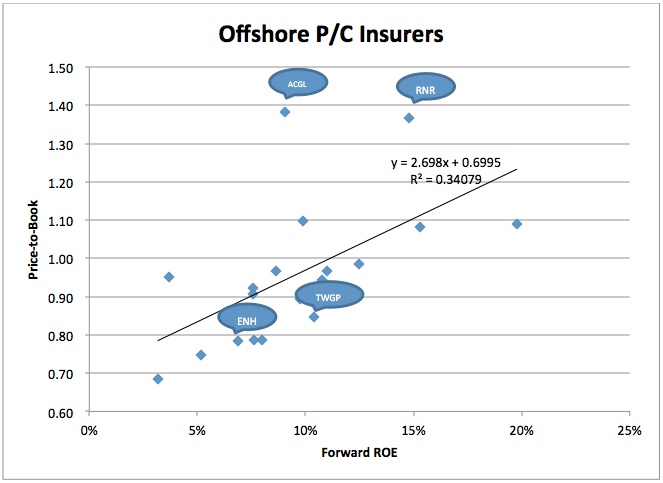
?
Companies above the line may be overvalued, and companies below the line may be undervalued.? ROE is what is expected by analysts for the next fiscal year, not what has been obtained in the past.
The fit is fairly tight, and indicates mostly logical valuations for this group.? The companies that are possibly overvalued are: Arch Capital [ACGL] and Renaissance Re [RNR]. Possibly undervalued: Tower Group [TWGP] and Endurance Specialty [ENH].
Now, this simple model can fail if you have an intelligent management team that has a better model.? Arch Capital and Renaissance Re may be that.? But with an expected ROE of less than 20%, it is hard to justify their valuation, when the average stock in this group needs an expected 11% ROE to be valued at book.
Why such a high ROE to get book?? Earnings quality.? Reinsurers have noisy earnings due to catastrophes.? You don?t give high valuations to companies that run hot or cold.? But the trick here is to see who is accumulating book value the fastest ? they tend to be the stars over time.? Endurance and Arch have been good at that.
Life
The life insurance business would be simple, if it indeed were only life insurance.? Much of the industry is handed over to annuities, and all manner of asset gathering.? Even life insurance can be made more complex through variable and variable universal life, where assets are invested in stocks, and do not receive a rate from the company.
Part of the trouble is that variable products are not simple, but the insurers offer guarantees for a fee.? When I see those products, my reaction is usually, ?How do they hedge that?!?
Thus I am concerned for insurers that are ?equity-sensitive? as I reckon them.? Here is the PB-ROE scatterplot:
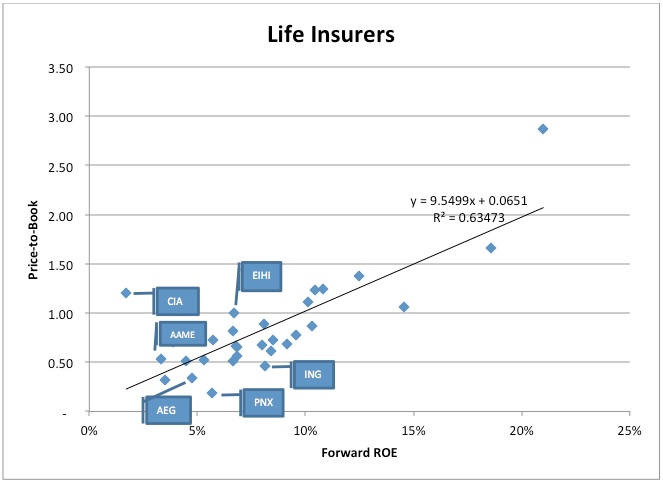
?
A tight fit.? The insurers that are seemingly undervalued are equity-sensitive ones: Phoenix Companies [PNX], Aegon [AEG], and ING [ING].? Those that are overvalued are Citizens [CIA], Eastern Insurance Holdings [EIHI], and Atlantic American [AAME].? For the undervalued companies, I am unlikely to buy because I am skeptical of the accounting.? I would look further down the list and consider buying some companies that are more reliable, like Assurant [AIZ], National Western [NWLI], and Fortegra Financial Corp [FRF].
One more note: to get book value in Life Insurance, you need a 9.8% ROE on average.? That?s high, but I expect that is so because investors are skeptical about the accounting.
Property & Casualty
This graph gives PB-ROE for the entire onshore P&C insurance industry:
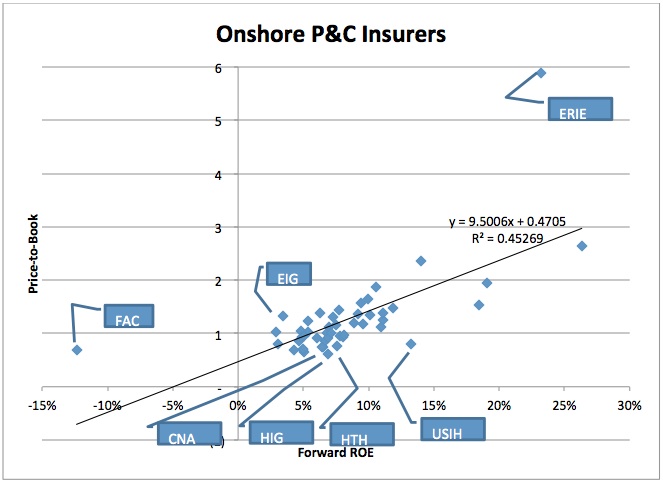
?
It?s a good fit.? Again, the casualties of the last year weigh on the property-centric insurers, but for the most part, this is logical.
Potential underperformers include First Acceptance [FAC], Employers Holdings [EIG], and Erie Indemnity [ERIE].? Below the line: Hartford Financial Services [HIG], Hilltop Holdings [HTH] Hartford Financial [HIG], and United Insurance Holdings [USIH].
Again, these are only screening tools.? Before buying or selling, understanding management and reserving quality, and riskiness of the lines of business makes a considerable difference.? Erie Indemnity has an ?asset light? model where it manages insurers, but does not bear underwriting risk.? Hartford has a significant life insurance and annuity exposure.? Models are models, and we have to understand their limitations.
Health
With Obamacare, I don?t know which end is up.? It could end up being a giant sop to the health insurers, or it could destroy the health insurers in order to create a government single-payer model, rather than the optimal model for cost reduction, where first parties pay directly, or pay insurers.? You want reductions in medical costs, get the government out of healthcare, and that includes the corporate deduction for employee health insurance.
My rationale is this: it could mess up the private market enough that the solution reached for is a single payer solution. I?ve talked with a decent number of health actuaries on this. The ability to price risk is distinctly limited. Young people pay too much, older folks too little. That?s a formula for antiselection. I think Obamacare was badly designed. I will not achieve its ends, and when the expenses start coming in, they will be far higher than anticipated. That has been the experience of the government in health care in the US. Utilization is underestimated, the further removed people from feeling its costs.
There are many models for profitability here, which makes things complex, but here is the present PB-ROE graph:

?
It?s an okay fit, with the idea that the following companies might be undervalued: Wellpoint [WLP] and Humana [HUM].? And the following overvalued: ?Molina Healthcare [MOH].
I don?t regard myself as an expert on the health insurance sub-industry, so treat this with skepticism.? I include it for completeness, because I think the PB-ROE concept has value in insurance.? One more note, the PB-ROE model thinks of this as a safe investment subindustry, because to have a book value valuation, you have to have an ROE of 1.8%.
Financial Insurers
This group comprises the surviving mortgage, title and financial insurers, and two companies in the ghoulish business of buying life insurance policies from sick people.? Here?s the PB-ROE graph:
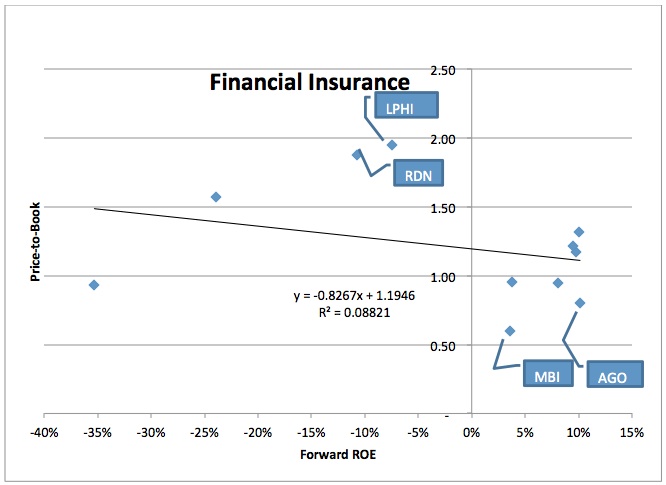
?
This graph is weird, because it slopes down, and does not have a good fit.? That?s because we?ve been through a rough period financially, and in many cases GAAP accounting does not do a good job with these companies that take a lot of credit risk.
We can still look for companies that have high price-to-book, and low ROEs ? note Life Partners [LPHI] and Radian [RDN] as possible sell candidates. We can also look for companies that have low price-to-book, and high ROEs ? note Assured Guaranty [AGO] and MBIA [MBI] as possible buy candidates.
This subsector is more difficult than most, because credit is not an underwritable risk.? It is feast and famine.? We are in a period of feast now, so in some ways what is bad is good.? The more risk, the more return.? But winter may come soon ? who knows what the Fed may do?? In general, I avoid this subsector for longs.
Insurance-Related Companies
This is a group that is a non-group.? It?comprises brokers and insurance service providers.? Here?s the PB-ROE graph:
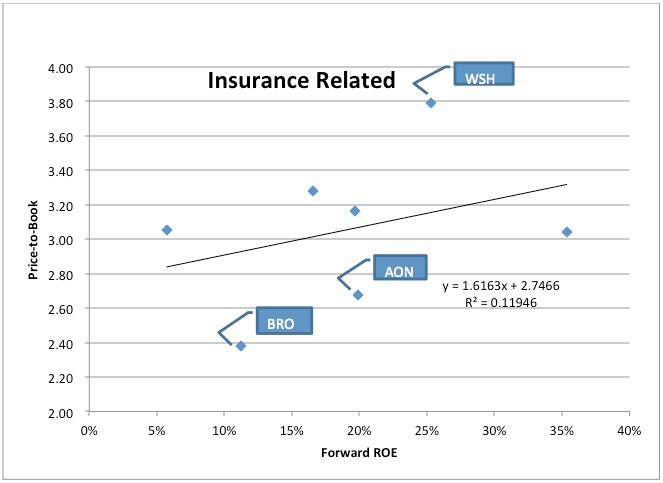
?
It doesn?t look like much of a group.
As it is the potential outperformers include?Brown & Brown [BRO], and Aon [AON], two leading insurance brokers.? A potential underperformer Willis Group [WSH], another leading insurance broker.
Summary
Insurance is complex, and the accounting is doubly complex, which is a major reason why many stay away from it.? But insurers as a group have had reliable and outsized returns over the rememberable past, which should encourage us to do a little kicking of the tires when a decent amount of the industry trades below its net worth and is still earning money with little debt.
In my opinion, this is a recipe for earnings in the future, and why I own a lot of insurers for myself, and for clients.
In the final part of this series, I will go over some nuances of insurance accounting ? I leave it to the end because it is kind of dull, but can make a lot of difference, because some companies look cheap and aren?t really cheap.
Full disclosure: long AIZ, ENH, NWLI for clients and myself
?
~~~
David J. Merkel, CFA is Principal of the equity and bond asset management firm Aleph Investments, LLC, and writes The Aleph Blog. Previously, he was the Director of Research for Finacorp Securities, Senior Investment Analyst at Hovde Capital, and a leading commentator at RealMoney.com.
Before that, he managed corporate bonds for Dwight Asset Management, mortgage bonds and investment risk at Mount Washington Investment Group, after working with Provident Mutual, AIG and Pacific Standard Life.
He holds Bachelor?s and Master?s degrees from Johns Hopkins. In his spare time, he takes care of his eight children with his wonderful wife Ruth.
Category: Investing, Think Tank
Leave a Reply
You must be logged in to post a comment.
Source: http://www.ritholtz.com/blog/2013/05/david-merkel-on-insurance-investing/
Closing Ceremony London 2012 Tom Daley Leryn Franco The Campaign Kinesio tape randy travis Allyson Felix
No comments:
Post a Comment
Note: Only a member of this blog may post a comment.